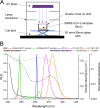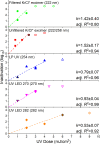UV Inactivation of SARS-CoV-2 across the UVC Spectrum: KrCl* Excimer, Mercury-Vapor, and Light-Emitting-Diode (LED) Sources
- PMID: 34495736
- PMCID: PMC8552892
- DOI: 10.1128/AEM.01532-21
UV Inactivation of SARS-CoV-2 across the UVC Spectrum: KrCl* Excimer, Mercury-Vapor, and Light-Emitting-Diode (LED) Sources
Abstract
Effective disinfection technology to combat severe acute respiratory syndrome coronavirus 2 (SARS-CoV-2) can help reduce viral transmission during the ongoing COVID-19 global pandemic and in the future. UV devices emitting UVC irradiation (200 to 280 nm) have proven to be effective for virus disinfection, but limited information is available for SARS-CoV-2 due to the safety requirements of testing, which is limited to biosafety level 3 (BSL3) laboratories. In this study, inactivation of SARS-CoV-2 in thin-film buffered aqueous solution (pH 7.4) was determined across UVC irradiation wavelengths of 222 to 282 nm from krypton chloride (KrCl*) excimers, a low-pressure mercury-vapor lamp, and two UVC light-emitting diodes. Our results show that all tested UVC devices can effectively inactivate SARS-CoV-2, among which the KrCl* excimer had the best disinfection performance (i.e., highest inactivation rate). The inactivation rate constants of SARS-CoV-2 across wavelengths are similar to those for murine hepatitis virus (MHV) from our previous investigation, suggesting that MHV can serve as a reliable surrogate of SARS-CoV-2 with a lower BSL requirement (BSL2) during UV disinfection tests. This study provides fundamental information on UVC's action on SARS-CoV-2 and guidance for achieving reliable disinfection performance with UVC devices. IMPORTANCE UV light is an effective tool to help stem the spread of respiratory viruses and protect public health in commercial, public, transportation, and health care settings. For effective use of UV, there is a need to determine the efficiency of different UV wavelengths in killing pathogens, specifically SARS-CoV-2, to support efforts to control the ongoing COVID-19 global pandemic and future coronavirus-caused respiratory virus pandemics. We found that SARS-CoV-2 can be inactivated effectively using a broad range of UVC wavelengths, and 222 nm provided the best disinfection performance. Interestingly, 222-nm irradiation has been found to be safe for human exposure up to thresholds that are beyond those effective for inactivating viruses. Therefore, applying UV light from KrCl* excimers in public spaces can effectively help reduce viral aerosol or surface-based transmissions.
Keywords: COVID-19; MHV; UV disinfection; bacteriophage Phi6; far UVC; human coronavirus 229E; murine hepatitis virus; surrogate.
Figures



Similar articles
-
Inactivation of Coronaviruses and Phage Phi6 from Irradiation across UVC Wavelengths.Environ Sci Technol Lett. 2021 Mar 17;8(5):425-430. doi: 10.1021/acs.estlett.1c00178. eCollection 2021 May 11. Environ Sci Technol Lett. 2021. PMID: 37566360
-
Robust Evaluation of Ultraviolet-C Sensitivity for SARS-CoV-2 and Surrogate Coronaviruses.Microbiol Spectr. 2021 Oct 31;9(2):e0053721. doi: 10.1128/Spectrum.00537-21. Epub 2021 Oct 20. Microbiol Spectr. 2021. PMID: 34668746 Free PMC article.
-
Reflection of UVC wavelengths from common materials during surface UV disinfection: Assessment of human UV exposure and ozone generation.Sci Total Environ. 2023 Apr 15;869:161848. doi: 10.1016/j.scitotenv.2023.161848. Epub 2023 Jan 26. Sci Total Environ. 2023. PMID: 36709900
-
COVID-19 pandemic lesson learned- critical parameters and research needs for UVC inactivation of viral aerosols.J Hazard Mater Adv. 2022 Nov;8:100183. doi: 10.1016/j.hazadv.2022.100183. Epub 2022 Oct 12. J Hazard Mater Adv. 2022. PMID: 36619826 Free PMC article. Review.
-
Viral Inactivation with Emphasis on SARS-CoV-2 Using Physical and Chemical Disinfectants.ScientificWorldJournal. 2021 Oct 25;2021:9342748. doi: 10.1155/2021/9342748. eCollection 2021. ScientificWorldJournal. 2021. PMID: 34712107 Free PMC article. Review.
Cited by
-
Far-UVC 222 nm Treatment: Effects of Nitrate/Nitrite on Disinfection Byproduct Formation Potential.Environ Sci Technol. 2024 Aug 12;58(34):15311-20. doi: 10.1021/acs.est.4c04258. Online ahead of print. Environ Sci Technol. 2024. PMID: 39133232 Free PMC article.
-
Comparative analysis of environmental persistence of SARS-CoV-2 variants and seasonal coronaviruses.Appl Environ Microbiol. 2025 Apr 23;91(4):e0168824. doi: 10.1128/aem.01688-24. Epub 2025 Mar 6. Appl Environ Microbiol. 2025. PMID: 40047423 Free PMC article.
-
Ultrafast inactivation of SARS-CoV-2 with 266 nm lasers.Sci Rep. 2022 Nov 4;12(1):18640. doi: 10.1038/s41598-022-23423-2. Sci Rep. 2022. PMID: 36333440 Free PMC article.
-
On the Use of the Intrinsic DNA Fluorescence for Monitoring Its Damage: A Contribution from Fundamental Studies.ACS Omega. 2024 Jun 13;9(25):26826-26837. doi: 10.1021/acsomega.4c02256. eCollection 2024 Jun 25. ACS Omega. 2024. PMID: 38947837 Free PMC article. Review.
-
Combating Coronavirus Using Resonant Electromagnetic Irradiation.IEEE J Electromagn RF Microw Med Biol. 2022 Aug 17;6(4):477-484. doi: 10.1109/JERM.2022.3194727. eCollection 2022 Dec. IEEE J Electromagn RF Microw Med Biol. 2022. PMID: 36514675 Free PMC article.
References
-
- World Health Organization. 2020. Transmission of SARS-CoV-2: implications for infection prevention precautions. World Health Organization, Geneva, Switzerland.
-
- van Doremalen N, Bushmaker T, Morris DH, Holbrook MG, Gamble A, Williamson BN, Tamin A, Harcourt JL, Thornburg NJ, Gerber SI, Lloyd-Smith JO, de Wit E, Munster VJ. 2020. Aerosol and surface stability of SARS-CoV-2 as compared with SARS-CoV-1. N Engl J Med 382:1564–1567. 10.1056/NEJMc2004973. - DOI - PMC - PubMed
Publication types
MeSH terms
Grants and funding
LinkOut - more resources
Full Text Sources
Other Literature Sources
Medical
Miscellaneous

